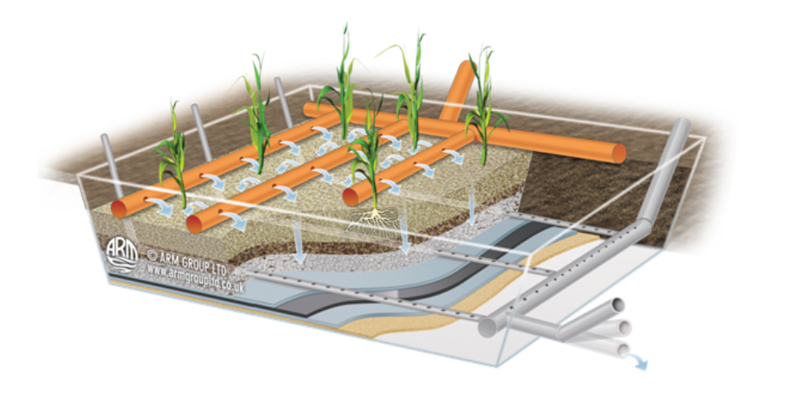- Mitigation title
- Reed beds
-

- Description
-
Reed bed systems are a type of Vertical Flow system that allow the water to flow beneath the gravel surface. It is a free draining batch flow system and so it is not constantly ‘flooded’.
To achieve a batch flow the effluent is delivered to the bed via a pump or siphon type system and the effluent is distributed over the bed, where it gradually drains down. The substrate goes through periods of being saturated with effluent and then aerated as it drains through.
As the effluent percolates down it is collected by drainage pipes at the bottom and can then be fed to other reed beds for further processing or discharged.
The main plant species in reed beds is the Common Reed plant (Phragmites Australis), the reed beds can also be dosed to increase nutrient removal.
- Advantages
-
- Can be fed by gravity (low energy use)
- Biodiversity enhancement
- Carbon sequestration
- Disadvantages
-
- Impacted by climate conditions
- Parameters
-
- Phosphorus
- Ammonia
- Nitrogen
- BOD/COD
- Carbon footprint
-
- Short term energy requirements for earth works
- Acts as a net carbon sink
- Time to become effective
-
- Gravel filtration will immediately remove suspended sediment
- Removal of nutrients / organic matter will first need vegetation to become established
- Maintenance
-
- Needs to be monitored frequently to ensure there is no bioclogging
- Gravel medium needs to be renewed as required
- Suggested cutting back of plants and removal of litter at the end of each growing season
- Performance with time
-
- Performance can be kept at optimum with well a well-established maintenance schedule
- Performance fluctuates with seasonal changes; lower in autumn/winter, highest in spring/summer
- Scaling considerations
-
The size of the reed beds and how many reed bed stages are required is correlated to the load of nutrient removal. Design criteria to meet:
- Monitoring required of the inlet and outlet concentrations and a Population Equivalent must be evidenced
- Hydraulic and mass loading will directly impact sizing, aspect ratio, and depth
- Must take into account climate factors and climate change, such as droughts and dry weather, or water gains from rainfall, etc. As well seasonal dynamics and differences in flows through different seasons
- Must take into account seasonal efficiency tied to plant growth
- References
-
ARM. (n.d.). Vertical Flow ARM Technology. Retrieved from https://armreedbeds.co.uk/projects/vertical-flow/
Dotro, G., G Langergraber, Pascal Molle, Nivala, J., Jaume Puigagut Juárez, Stein, O.R., Marcos Von Sperling and Iwa. (2017). Task Group On Mainstreaming The Use Of Treatment Wetlands . Treatment wetlands. London: Iwa Publishing.
Enviro Pro. (n.d.). Vertical flow reedbeds for Anglian Water. Retrieved from https://www.enviropro.co.uk/entry/139247/ARM-Ltd/Vertical-flow-reedbeds-for-Anglian-Water/
F. Masi, R. Bresciani, N. Martinuzzi, G. Cigarini, A. Rizzo. (2017). Large scale application of French reed beds: municipal wastewater treatment for a 20,000 inhabitants town in Moldova . Water Sci Technol .
Low Impact. (n.d.). Reed beds - introduction. Retrieved from https://www.lowimpact.org/categories/reed-beds
Natural England. (2022). Framework Approach for Responding to Wetland Mitigation Proposals.
Ricardo for Herefordshire Council. (2021). Interim Phosphate Delivery Plan Stage 2, Mitigation options for phosphate removal in the Wye Catchment.
Wetland Engineering. (n.d.). Treatment Wetlands. Retrieved from https://wetlandengineering.co.uk/treatment-wetlands
